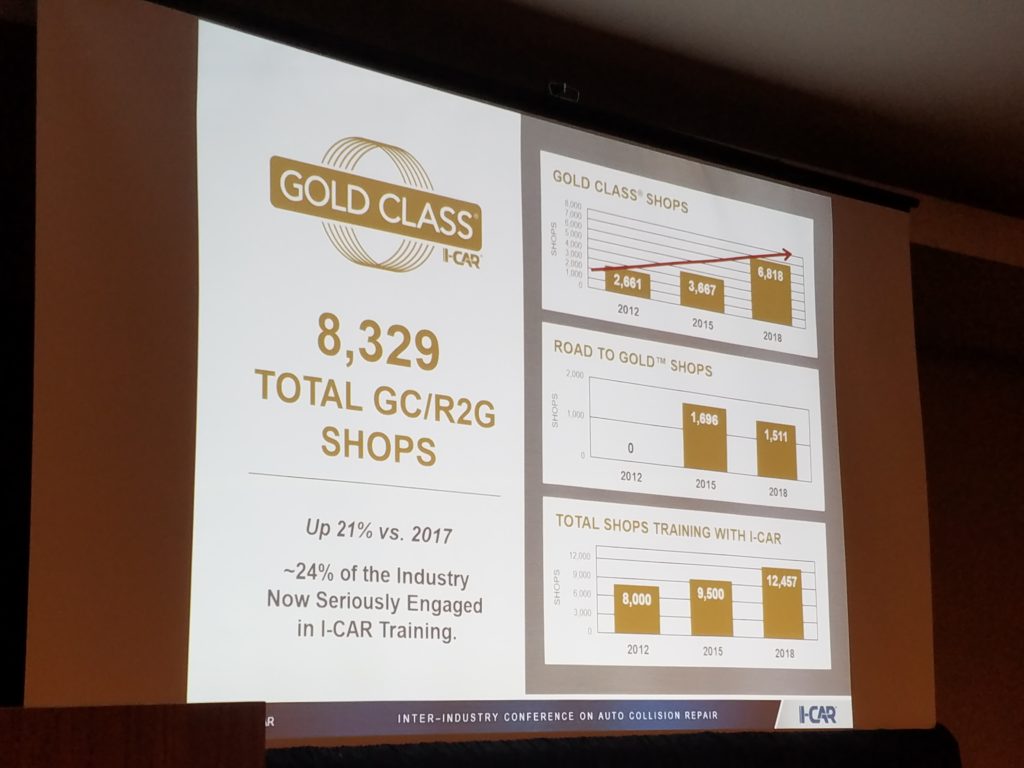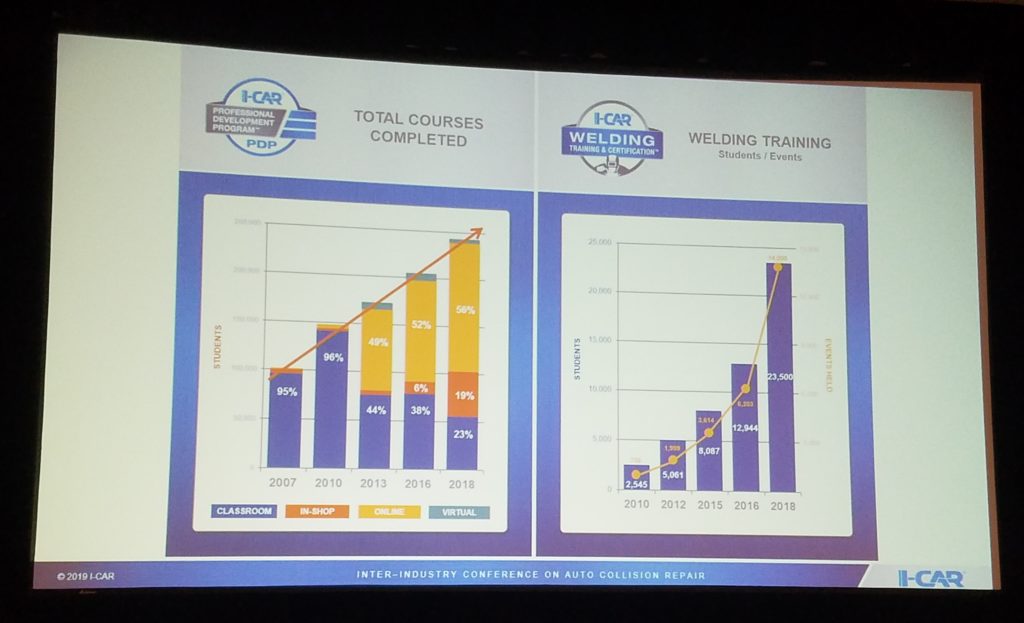
I-CAR reports gains in welding course penetration, Gold Class shops
By onAnnouncements | Associations | Business Practices | Education | Repair Operations
I-CAR on Thursday reported the collision industry grew to 8,329 shops having achieved either Gold Class or Road to Gold by the end of 2018, a 21 percent increase over 2017.
CEO John Van Alstyne presented data at a media event tallying 6,818 Gold Class shops by the end of 2018, nearly double the 3,667 from 2015. He called it a “pretty substantial chunk of growth there.”
Road to Gold shops declined to 1,511 from 1,696, but it was meant to be a means of getting to Gold Class, Van Alstyne said.
“We’re OK with it going down,” he said. Besides, I-CAR was going to eliminate Road to Gold anyway in February (Feb. 28) as a response to shops abusing the concept, according to Van Alstyne. A Road to Gold shop failing to reach Gold Class by the cutoff date will be stripped of its designation. Shops that clinched Gold Class by an unspecified date under the old rules were to get up to two years to bring themselves up to the tougher Gold criteria launching in April.
Overall, 12,457 shops were training with I-CAR in 2018, up from 9,500 in 2015. Another more than 1,600 had some kind of training requirement, which left 65 percent of an estimated 40,000 shops still not training, according to I-CAR.
Nearly 250,000 students trained with I-CAR in 2018, up from more than 200,000 in 2016. (It’s unclear if these numbers reflect unique students or the sum of each course’s enrollment.)
I-CAR’s stats showed a “substantial” increase in in-shop training (which would include the three welding certification classes) over 2016, Van Alstyne said. They also reflected a shift from classroom to in-shop training, and Van Alstyne said the latter would become “even bigger” in 2019.
Van Alstyne said welding had a “big spike,” referring to an I-CAR slide reporting welding students climbed to 23,500 from 12,944 in 2016, and welding events rose to 14,000 from 6,203 in 2016.
“We can thank State Farm a bit for that,” Van Alstyne said, calling the No. 1 insurer’s decision to require its direct repair program facilities to complete all three welding segments “fantastic.”
I-CAR projects about 46 percent of technicians who welded steel in 2018 weren’t I-CAR trained, which Van Alstyne called still “a big improvement over where we were.” About 69 percent of techs who welded in 2013 lacked I-CAR training, I-CAR estimated.
About 73 percent of technicians who welded lacked I-CAR’s steel sectioning training, which while pretty dismal is still better than the 98 percent of the industry I-CAR projected in 2013. Van Alstyne said the 2018 data indicated that while I-CAR was “quite busy,” it still had a large opportunity to help the industry.
Three-fourths of technicians welding aluminum didn’t have I-CAR’s relevant credential, down from an estimated 94 percent in 2013. Van Alstyne noted that aluminum credentials still tend to be optional.
More information:
I-CAR, Nov. 29, 2018
I-CAR “Train to Gain” Gold Class overhaul portal
Images:
I-CAR CEO John Van Alstyne at a Jan. 17, 2019, media event discusses statistics related to I-CAR welding training in 2018. (John Huetter/Repairer Driven News)
I-CAR Gold Class and Road to Gold statistics are shown at a Jan. 17, 2019, media event. (I-CAR slide; photo by John Huetter/Repairer Driven News)
This I-CAR slide from the Jan. 17, 2019, Collision Industry Conference demonstrates the growth in welding events and students over the past few years. (I-CAR slide; photo by John Huetter/Repairer Driven News)
I-CAR CEO John Van Alstyne at a Jan. 17, 2019, media event discusses statistics related to I-CAR welding training in 2018. (John Huetter/Repairer Driven News)



